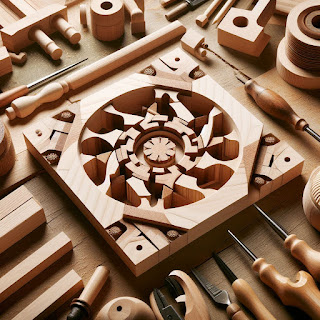Wood Types for Beginners: Wood-naming 101
- Pine: The Friendly Softwood: Known for its light color and affordability, pine is a softwood that's easy to work with. Despite its soft nature, pine boasts knotty charm and versatility, making it a popular choice for a wide range of projects. From rustic furniture to decorative accents, pine's warm tones and natural beauty shine through.
- Oak: The Stalwart Hardwood: Oak stands tall as a hardwood with durability written all over it. With its distinctive grain patterns and robust nature, oak is a favorite among furniture makers seeking strength and resilience. Whether crafting timeless pieces or adding structural support, oak's enduring qualities make it a stalwart choice in woodworking.
- Maple: The Smooth Operator: With its light color and fine grain, maple glides effortlessly as the smooth operator of the wood family. Loved for its versatility and workability, maple finds its niche in a variety of applications, from cabinets to cutting boards. Its clean appearance and consistent texture make it a go-to option for those seeking both beauty and functionality.
- Mahogany: The Exotic Beauty: Step into the world of mahogany – an exotic hardwood known for its rich, reddish-brown hue and luxurious appeal. Mahogany's stunning color and distinctive grain patterns exude elegance and sophistication, making it a top pick for high-end furniture and decorative accents. Despite its exotic origins, mahogany is prized for its workability and ability to take on a smooth finish with ease.
- Cedar: The Aromatic Wonder: Cedar adds a fragrant twist to the wood palette, delighting the senses with its distinctive aroma and natural beauty. Beyond its pleasing scent, cedar boasts natural resistance to insects and decay, making it a popular choice for outdoor projects such as decks, fences, and garden furniture. Its warm tones and weather-resistant properties make cedar a timeless favorite in woodworking projects.
Choosing the Right Wood for Your Project: Crafting with Purpose
Now that you've met the diverse members of the Wood family, it's time to talk strategy. Choosing the right wood for your project is akin to selecting the perfect ingredient for a recipe – it sets the foundation for success. Let's dive into the decision-making process and equip you with the knowledge to make informed choices that enhance the beauty and longevity of your creations.
- Know Your Wood: Before diving into your project, take the time to familiarize yourself with the characteristics of different wood types. Consider factors such as wood hardness, grain patterns, and color variations. Understanding these traits will help you choose a wood species that aligns with your project requirements and aesthetic preferences.
- Consider Wood Hardness: Depending on the intended use of your project, wood hardness plays a crucial role in its durability and longevity. Hardwoods like oak and mahogany are well-suited for furniture and structural elements, thanks to their strength and resistance to wear and tear. On the other hand, softwoods like pine and cedar are ideal for decorative accents and projects where ease of workability is paramount.
- Evaluate Grain Patterns: The grain pattern of wood can significantly impact the visual appeal of your project. Straight grain patterns offer a clean and uniform look, while figured grain patterns like quartersawn oak or curly maple add character and depth. Consider the aesthetic effect you wish to achieve and select a wood species with grain patterns that complement your design.
- Factor in Intended Use: Beyond aesthetics, consider the practical aspects of your project's intended use. Will it be exposed to moisture or outdoor elements? Is structural stability a priority? Choosing a wood species with suitable characteristics for the intended application – such as moisture resistance for outdoor projects or structural strength for load-bearing components – ensures the longevity and functionality of your creation.
- Balance Cost and Quality: Finally, strike a balance between cost and quality when selecting wood for your project. While exotic hardwoods may offer unparalleled beauty, they often come with a hefty price tag. Consider alternative wood species that offer similar characteristics at a more affordable price point. Remember, the goal is to achieve the best possible outcome within your budget constraints.
By approaching wood selection with purpose and consideration, you'll set the stage for woodworking success. Whether you're crafting furniture, decorative accents, or structural elements, choosing the right wood species tailored to your project's requirements ensures a result that's both beautiful and enduring. So, let's roll up our sleeves and start crafting with purpose – the Wood family is ready to lend its strength, beauty, and character to your creations!
Share Your Wood Wisdom!
Have you recently worked on a project that showcased the characteristics of a specific wood type? Or perhaps you have questions about choosing the right wood for your next venture? Share your wood wisdom, experiences, or queries by leaving a comment below. Let's create a vibrant community where the love for woodworking and knowledge exchange thrives. Happy woodworking!
We are very excited to share with you our official Facebook Page Dosefornia Furniture where you will be updated with the latest projects I do.





































